Of all the guitar scales you’ll dive into, pentatonic scales are likely to become a cornerstone of your playing. For decades, these scales have been the secret weapon behind countless iconic guitar solos, offering you the perfect launchpad for crafting your own expressive lead lines.
Like many scales, the pentatonic scale has roots in the major scale. The prefix “penta” signifies five, and true to its name, the pentatonic scale is built with just five notes. These five notes are derived by taking a major scale and strategically removing the 4th and 7th degrees.
By omitting these two notes, we smooth out some of the more harmonically complex intervals within the major scale. This creates a more versatile and forgiving scale, ideal for improvisation and soloing. You gain the freedom to explore without constantly worrying about hitting a dissonant or “wrong” note.
Ready to Elevate Your Guitar Skills? 🎸
Accelerate your learning and play your favorite songs faster than ever with Guitareo’s interactive practice tools. Unlock a world of guitar knowledge and start your 7-day free trial today!
TRY GUITAREO
This guide introduces you to pentatonic scales, drawing from the comprehensive 12-part Lead Guitar Quick-Start Series. If you’re eager to delve deeper into lead guitar techniques like vibrato, bending, and explore a wider range of scales, this series is your ultimate resource. Let’s begin with the essential major pentatonic scale.
Discovering the Major Pentatonic Scale
There are two fundamental forms of the pentatonic scale: the major pentatonic and the minor pentatonic. We’ll start by examining the major pentatonic scale.
Mastering this scale shape requires some finger agility, as you’ll utilize all four fingers in varied patterns across the fretboard. Begin slowly, focusing on learning the shape one string at a time. Here’s the complete diagram for a G major pentatonic scale:
 G Major Pentatonic Scale Shape
G Major Pentatonic Scale Shape
For those new to scale diagrams, the black circles indicate the root notes, which are G notes in this G major pentatonic scale. Root notes always define the scale’s name.
Using the root notes (black circles) as your starting points, you’ll notice the five notes repeat across nearly two and a half octaves within this shape.
To enhance your practice, we’ve included a jam track. Playing along with a backing track makes learning scales more engaging and helps you internalize the shapes more effectively.
Unveiling the Minor Pentatonic Scale
The minor pentatonic scale is the second essential pentatonic form, and it’s likely to become your go-to scale for guitar solos. Its popularity stems from its simplicity and ease of use.
This six-string shape uses only two distinct patterns, making it incredibly easy to learn and memorize. Here’s the minor pentatonic shape:
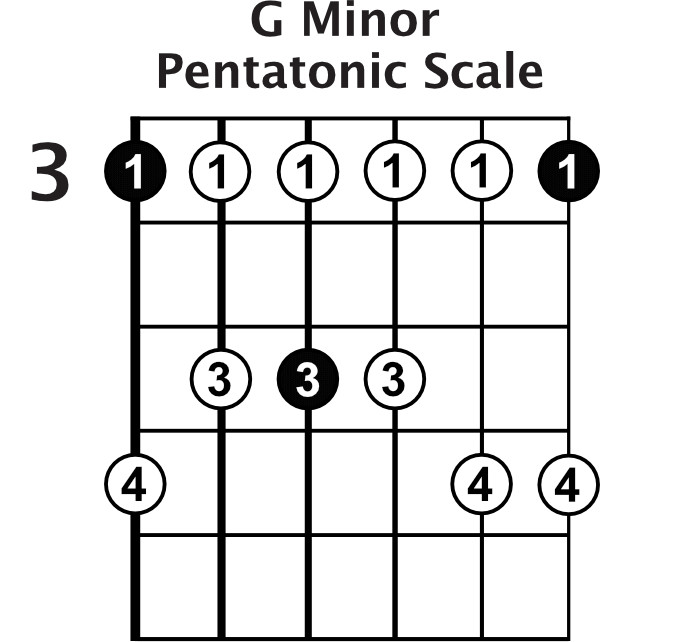 G Minor Pentatonic Scale Shape
G Minor Pentatonic Scale Shape
As you can see, the minor pentatonic scale begins on the same root note as the major pentatonic shape but employs a different pattern. One scale is derived from the G major key, while the other comes from the G minor key.
Download the provided jam track and practice this minor pentatonic scale shape along with it. It’s crucial to become comfortable with both major and minor pentatonic shapes before progressing further.
The 5 Essential Pentatonic Scale Shapes
By now, you should be familiar with two of the five pentatonic scale shapes. These five shapes, when combined, cover twelve frets before repeating and are seamlessly connected.
Imagine all possible positions to play the five notes of the pentatonic scale across the entire fretboard. Arranging these positions reveals five distinct shapes within a twelve-fret span.
Shape #1: The first shape should already be familiar – it’s position one of the major pentatonic scale, based on an E major shape chord. Comparing the scale shape to the E major chord, you’ll see how they overlay. The scale incorporates all notes from the chord and adds others from within the key.
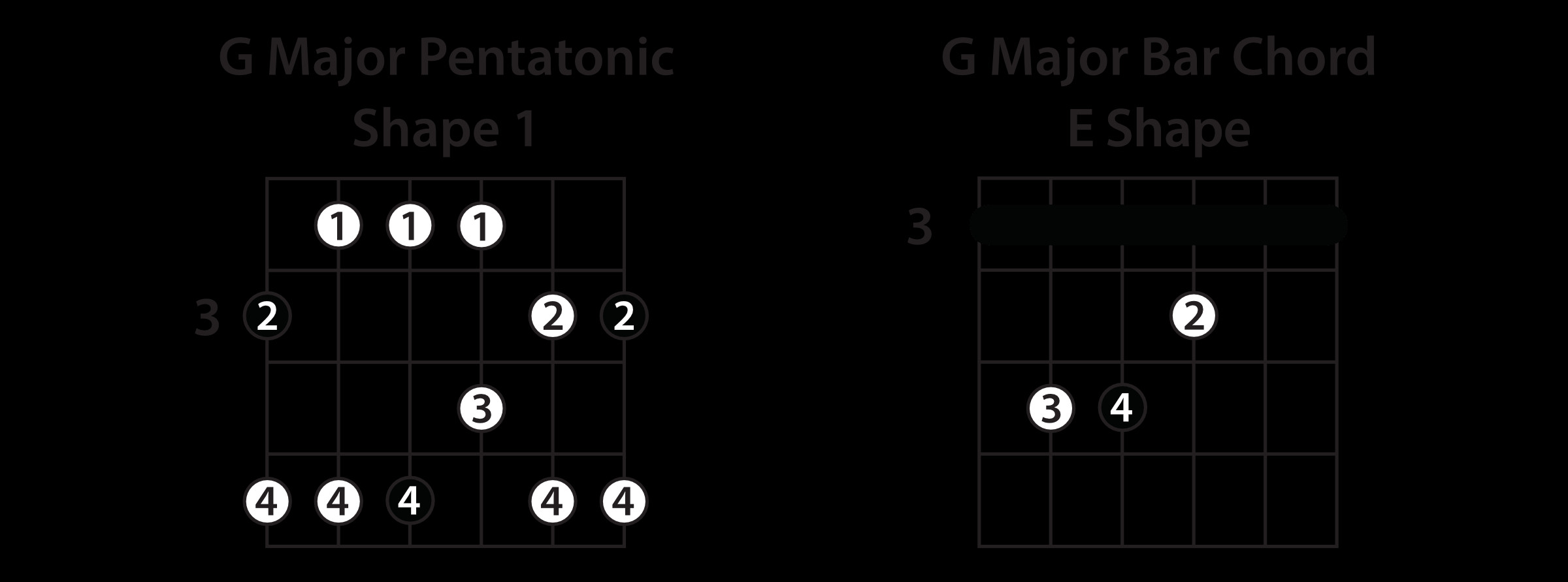 Pentatonic Scale Shape 1 – E Major Chord Shape
Pentatonic Scale Shape 1 – E Major Chord Shape
Visualizing chord shapes within scale shapes is a powerful memorization technique and helps identify root note locations.
Shape #2: The second shape begins where the first shape ends. Note the root notes; this shape mirrors a D major shaped chord.
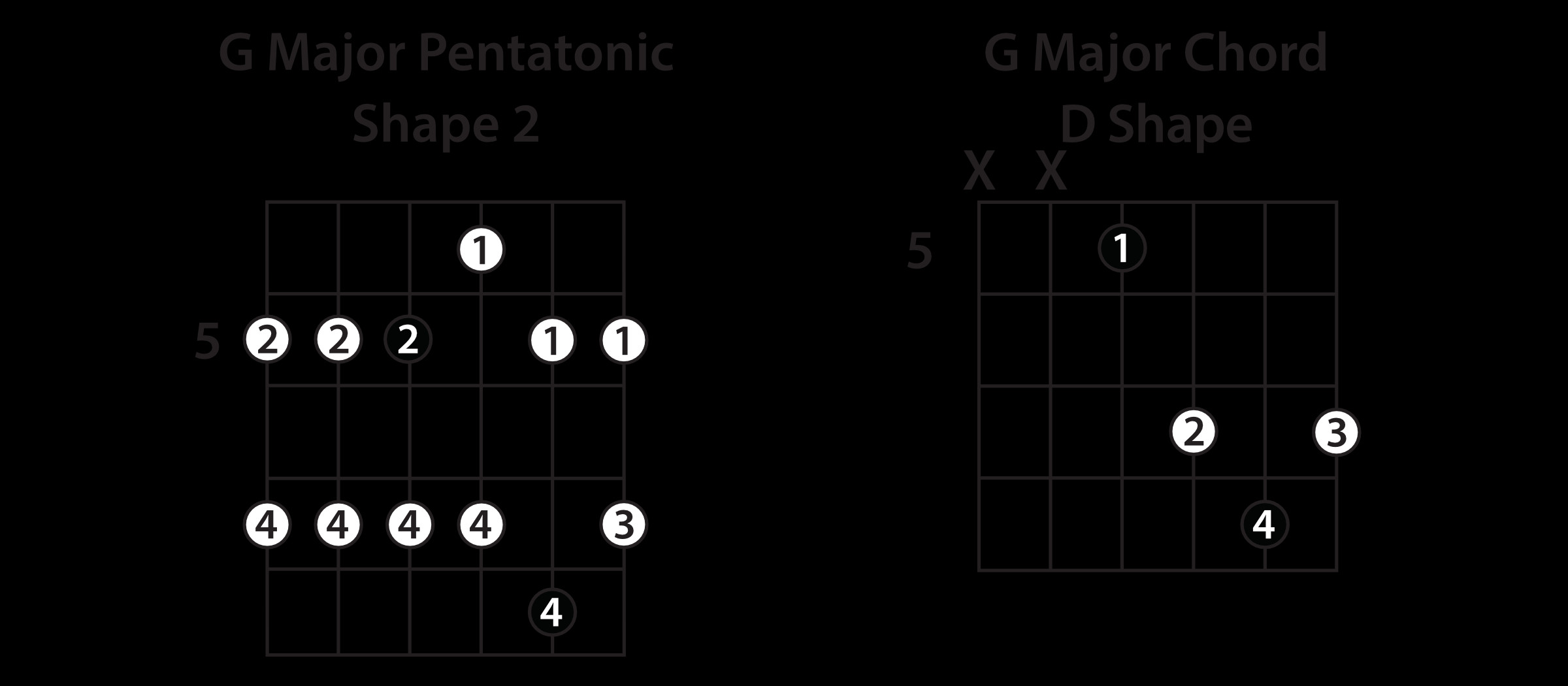 Pentatonic Scale Shape 2 – D Major Chord Shape
Pentatonic Scale Shape 2 – D Major Chord Shape
As you navigate between shapes, pay close attention to their connections. As your guitar skills develop, you’ll naturally transition between shapes rather than staying confined to one.
Shape #3: Moving further up the fretboard, shape #3 outlines a C major shaped chord. Remember, it’s still the same five-note scale repeating in different octaves. The G root notes remain highlighted in black.
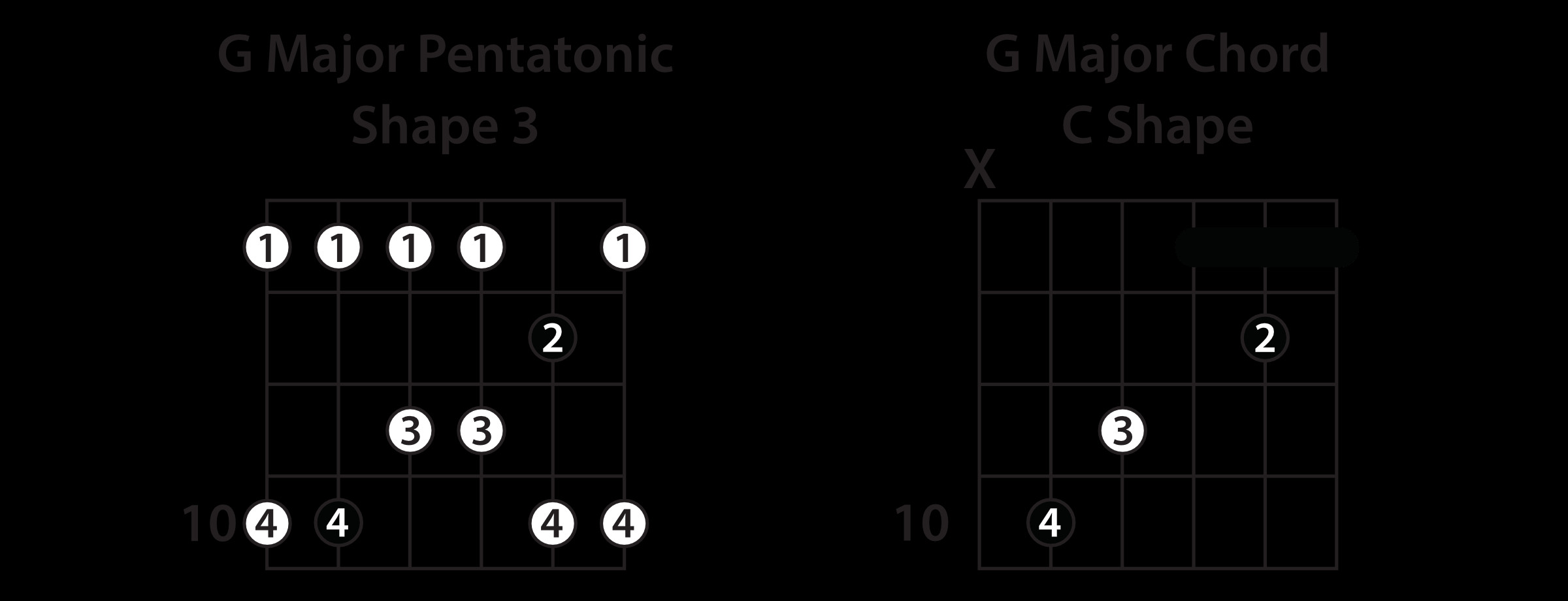 Pentatonic Scale Shape 3 – C Major Chord Shape
Pentatonic Scale Shape 3 – C Major Chord Shape
Shape #4: Shape #4, with its two-pattern structure, is another easily memorized shape. It aligns with the A major shape bar chord. Observe the connection points between shapes #3 and #4.
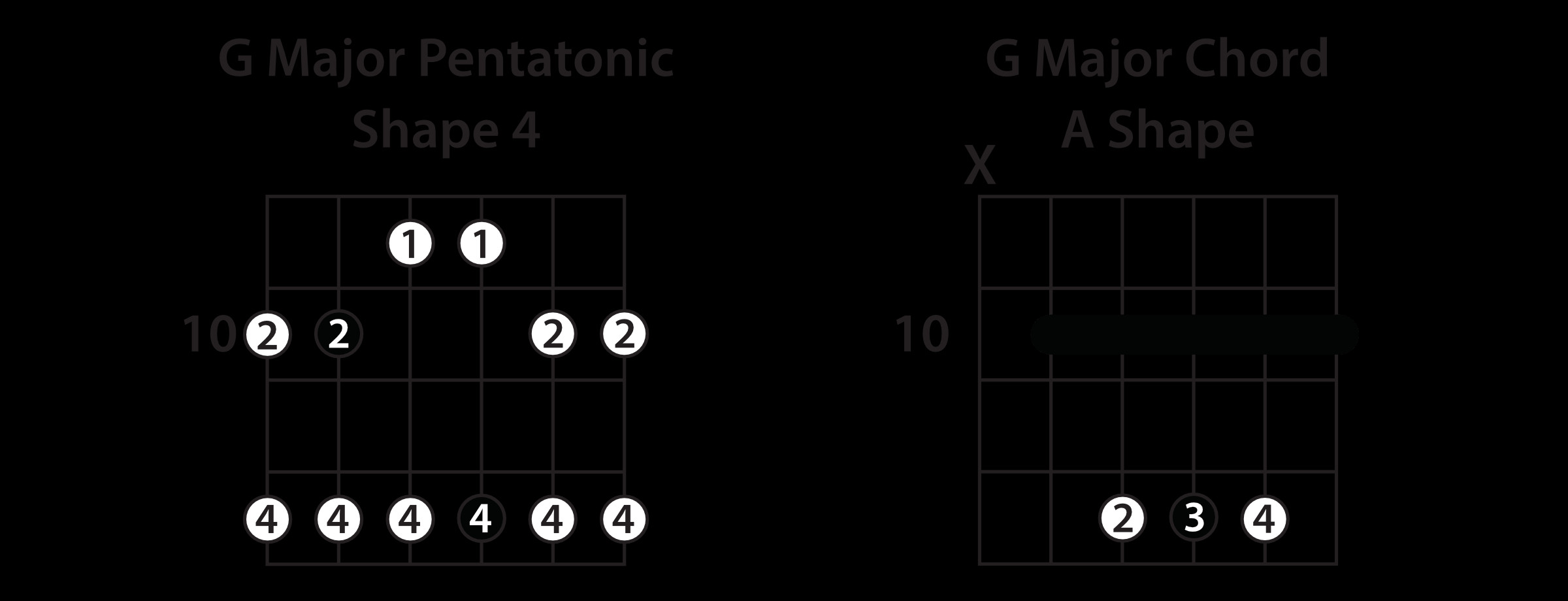 Pentatonic Scale Shape 4 – A Major Chord Shape
Pentatonic Scale Shape 4 – A Major Chord Shape
Shape #5: You might be wondering where the minor pentatonic shape fits into this sequence. The minor pentatonic shape is the fifth and final shape. It appears different from the earlier G minor scale shape because that was a G minor scale, not G major. This Shape #5 in G major outlines a standard G major chord.
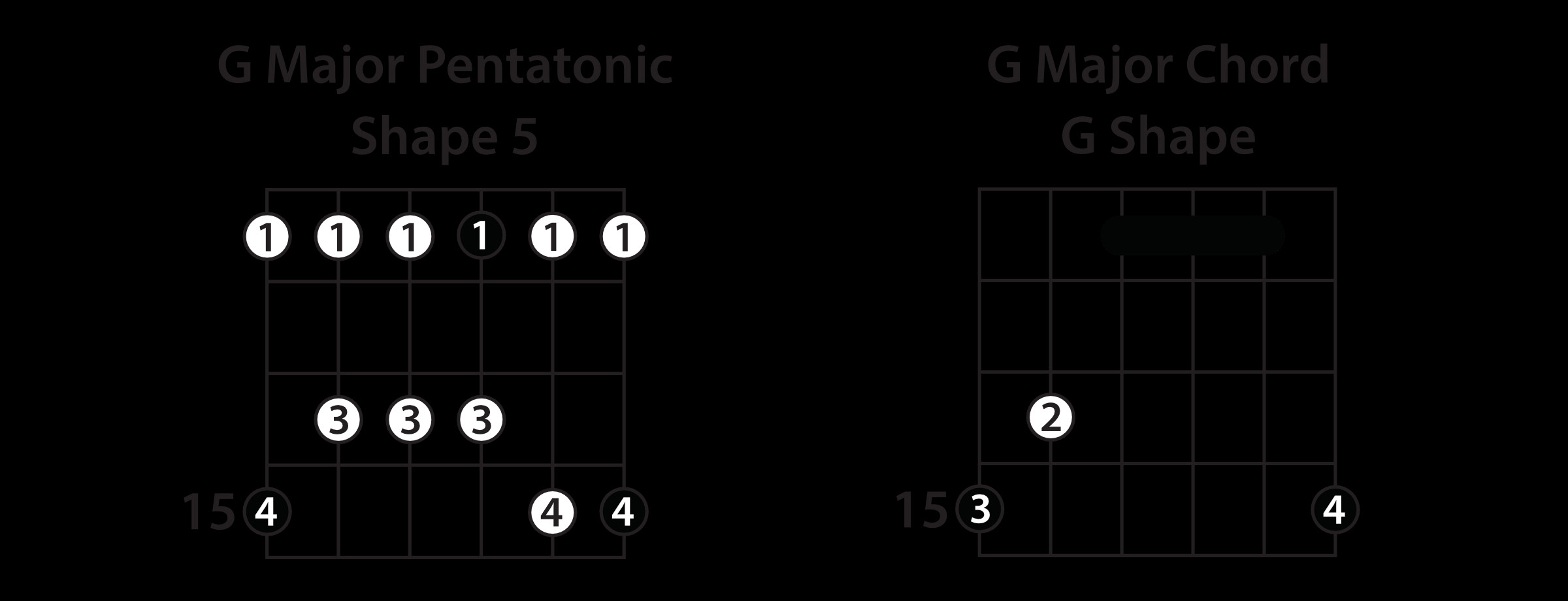 Pentatonic Scale Shape 5 – G Major Chord Shape
Pentatonic Scale Shape 5 – G Major Chord Shape
Major and Minor Pentatonic Relationship
Understanding the relationship between major and minor keys is crucial for utilizing pentatonic scales effectively. If major and minor keys are a new concept, here’s a brief explanation.
Every major key has a relative minor key sharing the exact same seven notes. To find the relative minor, locate the sixth note of the major scale. This sixth note names the relative minor key. In G major, the sixth note is E, making E minor the relative minor.
G Major Scale: G A B C D E F#
Sixth Note: E
E Minor Scale: E F# G A B C D
Both scales contain identical notes, and consequently, the same chords. Hence the term “relative.” This concept applies directly to pentatonic scales.
The five G major pentatonic shapes are identical to the five E minor pentatonic shapes. The only distinction lies in the root notes: in E minor pentatonic, the root notes are Es, not Gs.
Here’s the E minor pentatonic scale, showing its identical shape and position to the fifth G major pentatonic shape:
 E Minor Pentatonic Scale Shape
E Minor Pentatonic Scale Shape
When playing minor pentatonic scales, emphasize the root notes of the relative minor (E in this case) more than the major root notes (G). This means highlighting the E notes when improvising or creating lead lines.
This guide provides a solid foundation in Pentatonic Scales For Guitar. You now have a comprehensive understanding of both major and minor pentatonic shapes. This is just the beginning of your lead guitar journey, with much more to explore and enjoy. Continue scrolling for more lessons on pentatonic scales.
Further Guitar Lessons to Explore
Pentatonic Navigation Tips
You know the shapes, but how do you connect them fluidly like your guitar heroes? Nate Savage reveals the pathways between pentatonic shapes in this insightful lesson.
Minor Pentatonic Magic
Join Ayla Tesler-Mabe on a journey into the minor pentatonic scale. Learn techniques to break free from scale boxes and improvise solos with greater emotion and expression.
A Guide To Improvising Guitar Solos
Transform from beginner to guitar hero with this complete guide to improvising guitar solos. Start with a single scale shape and progress to creating original solos on the spot!
Want to accelerate your guitar progress? Unlock Guitareo’s interactive practice tool and learn from world-class instructors. Click the button below to begin your 7-day free trial today:
TRY GUITAREO FOR 7 DAYS
SHARE THIS:
 Andrew Clarke – Guitar Educator and Content Creator
Andrew Clarke – Guitar Educator and Content Creator
